How to Prepare Your Drone for All Seasons in Ballarat Central
Understanding Seasonal Challenges
Operating a drone in Ballarat Central presents unique challenges across different seasons. Each season brings its own weather conditions, which can significantly impact your drone's performance. Understanding these variations is the first step in preparing your drone for all-year-round operations.
In winter, drones face cold temperatures and potential snow that can affect battery life and visibility. Spring introduces higher humidity levels and rain, while summer brings heat that may overheat your drone's components. Finally, autumn's increasing winds can challenge flight stability. Being aware of these seasonal factors will help you prepare accordingly.

Preparing Your Drone for Winter
Winter in Ballarat Central can be harsh, with cold temperatures and occasional snowfall. To ensure your drone remains operational, begin by checking the battery health regularly. Cold weather can reduce battery efficiency, so keeping spare batteries warm before use is advisable.
Additionally, moisture from snow can damage your drone's internal components. After each flight, inspect your drone thoroughly for any signs of moisture and ensure it's completely dry before storing. Strong winds are another winter challenge, so practicing flights in open areas away from obstacles is wise.
Springtime Maintenance Tips
Spring brings rain and humidity, which can be detrimental to a drone if not managed properly. It is crucial to invest in a waterproof case or cover to protect your drone when not in use. Before each flight, check the weather forecast to avoid unexpected rain showers.
Furthermore, spring is an excellent time for a detailed maintenance check. Clean the propellers and inspect all moving parts for any wear or damage accumulated over the winter months. Keeping your drone well-maintained will ensure optimal performance during this season.

Summer Flight Precautions
The summer heat in Ballarat Central can lead to overheating, which might cause your drone to malfunction mid-flight. It's important to avoid flying during peak sun hours and to choose early morning or late afternoon for flights when temperatures are cooler.
Monitor the temperature of your drone's battery closely and allow it to cool down between flights. Heat can also affect GPS accuracy, so always perform a thorough pre-flight check to ensure the GPS is functioning correctly before takeoff.
Navigating Autumn Winds
Autumn in Ballarat Central can bring unpredictable winds that pose stability challenges for drones. To combat this, regularly calibrate your drone's compass and ensure the flight control system is up-to-date with the latest firmware.
During windy conditions, it is essential to practice flying in manual mode. This skill will allow you greater control over your drone's movement and help you respond swiftly to sudden gusts of wind. Consider using propeller guards for additional protection against potential impacts.

General Maintenance Tips for All Seasons
Regardless of the season, maintaining a regular maintenance routine is vital for the longevity of your drone. Always conduct a pre-flight checklist that includes checking battery levels, propeller condition, and ensuring all connections are secure.
After each flight, clean your drone to remove any dust or debris that might have accumulated. Store it in a cool, dry place away from direct sunlight or extreme temperatures to prevent any long-term damage.
Conclusion: Fly with Confidence Year-Round
By preparing your drone for the seasonal changes in Ballarat Central, you can enjoy seamless flights throughout the year. Remember, understanding the specific challenges each season presents and taking proactive measures will not only extend the life of your drone but also enhance your flying experience.
With these tips and regular maintenance, you'll be ready to capture stunning aerial views of Ballarat Central no matter what the season throws your way. Happy flying!